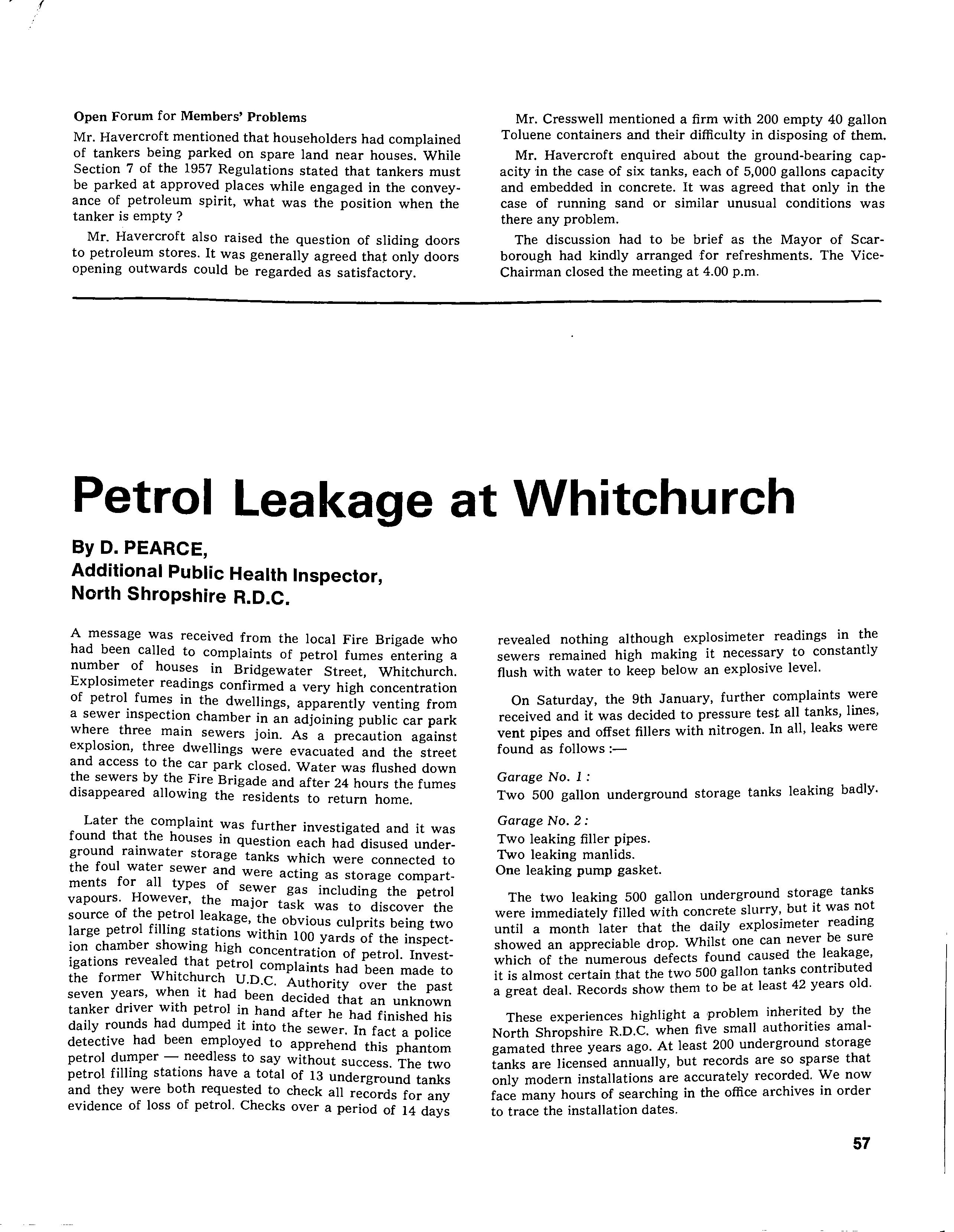
3 minute read
Petrol Leakage
by apeauk
Open Forum for Members' Problems Mr. Havercroft mentioned that householders had complained of tankers being parked on spare land near houses. While Section 7 of the 1957 Regulations stated that tankers must be parked at approved places while engaged in the conveyance of petroleum spirit, what was the position when the tanker is empty?
Mr. Havercroft also raised the question of sliding doors to petroleum stores. It was generally agreed that only doors opening outwards could be regarded as satisfactory.
Advertisement
Mr. Cresswell mentioned a firm with 200 empty 40 gallon Toluene containers and their difficulty in disposing of them.
Mr. Havercroft enquired about the ground-bearing capacity in the case of six tanks, each of 5,000 gallons capacity and embedded in concrete. It was agreed that only in the case of running sand or similar unusual conditions was there any problem.
The discussion had to be brief as the Mayor of Scarborough had kindly arranged for refreshments. The ViceChairman closed the meeting at 4.00 p.m.
Petrol Leakage at Whitchurch
By D. PEARCE, Additional Public Health Inspector, North Shropshire R.D.C.
A message was received from the local Fire Brigade who had been called to complaints of petrol fumes entering a of in Bridgewater Street, Whitchurch. Exploslmeter readmgs confirmed a very high concentration of petrol. fumes in the dwellings, apparently venting from a sewer mspection chamber in an adjoining public car park where. three main sewers join. As a precaution against explOSIOn, three dwellings were evacuated and the street and access to the car park closed. Water was flushed down the sewers by the Fire Brigade and after 24 hours the fumes disappeared allowing the residents to return home.
Later the complaint was further investigated and it was found the houses in question each had disused underground ramwater storag t k . e an s whIch were connected to the foul water sewer and . f 11 were actmg as storage compart-ments or a types of '. sewer gas mcludmg the petrol vapours. However, the maJ'or task was t 0 d' Iscover th e source of the petrol leakage the obvl'ous I 't b' t 1 f'll' .' cu pn s elOg wo large petro I 109 statIOns within 100 d f h . . h . yar sot e lOspect-IOn chamber s owlOg ., e 1 d th t IgatlOns rev a e . a high concentratl'on f t I I t0 pe ro. nves petrol complaints had been made to the former Whltchurch U D C Autho't th h . . . . n y over e past seven years, w en It had been decI'ded th t k . . a an un nown tanker drIver WIth petrol hand after he had finished his daily rounds had dumped It into the sewer. In fact a police detective had been employed to apprehend this phantom petrol dumper - needless to say without success. The two petrol filling stations have a total of 13 underground tanks and they were both requested to check all records for any evidence of loss of petrol. Checks over a period of 14 days revealed nothing although explosimeter readings in the sewers remained high making it necessary to constantly flush with water to keep below an explosive level.
On Saturday, the 9th January, further complaints received and it was decided to pressure test all tanks, lmes, vent pipes and offset fillers with nitrogen. In all, leaks were found as follows :-
Garage No. 1 : Two 500 gallon underground storage tanks leaking badly.
Garage No. 2 : Two leaking filler pipes. Two leaking manlids. One leaking pump gasket.
The two leaking 500 gallon underground tanks were immediately filled with concrete slurry,. but It was ?ot until a month later that the daily exploslmeter readmg showed an appreciable drop. Whilst one can never be sure which of the numerous defects found caused the it is almost certain that the two 500 gallon tanks contrIbuted a great deal. Records show them to be at least 42 years old.
These experiences highlight a problem by the North Shropshire R.D.C. when five small authOrItIes amalgamated three years ago. At least 200 underground storage tanks are licensed annually, but records only modern installations are accurately are so sparse '!'le that now face many hours of searching in the office archIves m order to trace the installation dates.







